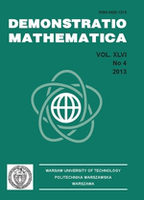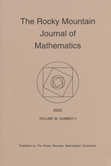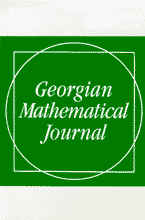
Russian Mathematics
Scope & Guideline
Unveiling Innovative Mathematical Insights
Introduction
Aims and Scopes
- Functional Analysis and Differential Equations:
Research on functional spaces, operator theory, and differential equations is a primary focus, exploring solutions and properties of various types of equations, including linear and nonlinear forms. - Approximation Theory and Numerical Methods:
The journal features significant contributions to approximation theory, including polynomial approximation, numerical methods for solving differential equations, and stability analysis of numerical schemes. - Mathematical Modeling and Applications:
Papers often involve mathematical modeling in applied fields such as physics, engineering, and biology, demonstrating how mathematical techniques can be used to solve real-world problems. - Algebraic Structures and Their Applications:
Research on algebraic structures, including semigroups, algebras, and Lie groups, is prevalent, often linking these structures to broader mathematical theories and applications. - Complex Analysis and Function Theory:
The journal includes studies on complex functions, integral equations, and boundary value problems, contributing to the understanding of complex analysis and its applications. - Geometric Analysis and Topology:
Exploration of geometric and topological aspects of mathematical structures, including studies on manifolds, curvature, and geometric flows, is a notable feature. - Stochastic Processes and Mathematical Logic:
Emerging themes in stochastic analysis and mathematical logic highlight the intersection of probability theory with other mathematical disciplines.
Trending and Emerging
- Nonlinear Dynamics and Chaos Theory:
An increasing number of papers focus on nonlinear dynamics and chaos, reflecting the growing interest in understanding complex systems and their behaviors. - Machine Learning and Data Analysis Techniques:
The integration of machine learning methodologies and data analysis into mathematical research is on the rise, indicating a significant trend towards interdisciplinary approaches. - Fractional Calculus and Its Applications:
Research on fractional calculus has gained momentum, with applications extending into various fields, including physics and engineering, highlighting its relevance in modern mathematical analysis. - Advanced Numerical Methods and Computational Mathematics:
There is a noticeable trend towards the development of sophisticated numerical methods for solving complex mathematical problems, particularly in applied contexts. - Mathematical Biology and Ecology Modeling:
Emerging themes in mathematical biology and ecological modeling indicate a growing interest in applying mathematical techniques to biological systems and population dynamics.
Declining or Waning
- Classical Geometry and Trigonometry:
Research in classical geometry and basic trigonometric methods appears to be decreasing, possibly due to the growing focus on more abstract and higher-dimensional mathematical theories. - Elementary Number Theory:
Papers focusing on elementary number theory, while still present, are less frequent, reflecting a potential shift towards more complex and applied mathematical problems. - Traditional Combinatorial Problems:
There seems to be a waning interest in traditional combinatorial problems, with fewer contributions compared to the past, as researchers gravitate towards more abstract algebraic and topological topics. - Basic Statistical Methods:
While statistical methods remain important, the journal has seen a decline in basic statistical analyses, suggesting a move towards more advanced probabilistic models and applications. - Foundational Studies in Logic:
The foundational studies in mathematical logic, although crucial, have become less prominent, possibly overshadowed by applied logic and computational aspects.
Similar Journals

Demonstratio Mathematica
Empowering Innovation in Mathematical ResearchDemonstratio Mathematica, published by DE GRUYTER POLAND SP Z O O, is an esteemed open-access journal in the field of mathematics, with an ISSN of 0420-1213 and E-ISSN 2391-4661. Established in 1996 and providing open access since 2009, it has become a vital platform for disseminating innovative research and advancements in various areas of mathematics. With a commendable Scopus ranking of 85/399 in General Mathematics and a 2023 Category Quartile of Q2, it stands at the forefront of the mathematical community, demonstrating a significant impact within the top 78th percentile. The journal aims to foster a deeper understanding and appreciation of mathematical concepts and their applications, catering to both seasoned researchers and emerging scholars. Located in Warsaw, Poland, Demonstratio Mathematica not only enriches the academic discourse but also strengthens collaborative efforts within the international mathematics community, making it an essential resource for those seeking to expand their knowledge and research output.

ROCKY MOUNTAIN JOURNAL OF MATHEMATICS
Elevating Mathematical Discourse Since 1971ROCKY MOUNTAIN JOURNAL OF MATHEMATICS, published by the Rocky Mountain Math Consortium, serves as a critical platform for researchers and practitioners in the field of mathematics since its inception in 1971. With a notable presence in the academic community, this journal covers a broad spectrum of mathematical disciplines, positioning itself in the Q2 category for Mathematics (miscellaneous) as of 2023. Despite being a subscription-based journal, it is recognized for its rigorous peer-review process and contributions to theoretical and applied mathematics, helping to advance knowledge and foster collaboration among mathematicians. The journal's ISSN number is 0035-7596 and its E-ISSN is 1945-3795, reflecting its commitment to accessibility and dissemination of high-quality research. Based in Tempe, Arizona, at Arizona State University, the journal continues to play an important role in shaping contemporary mathematical discourse through well-researched articles and innovative studies, aiming to bridge gaps between various mathematical subfields and engage a diverse audience, including students and established researchers alike.

Rendiconti del Circolo Matematico di Palermo
Cultivating Mathematical Excellence Since 1887.Rendiconti del Circolo Matematico di Palermo, published by SPRINGER-VERLAG ITALIA SRL, is a revered journal in the field of mathematics, emphasizing the cultivation and dissemination of mathematical knowledge since its inception in 1887. With its ISSN 0009-725X and E-ISSN 1973-4409, this esteemed publication has continued to thrive, showcasing innovative research, comprehensive reviews, and thoughtful discussions from diverse areas in mathematics, particularly in its Q2 ranking within the miscellaneous mathematics category. Its historical significance is underscored by its convergence of publications across numerous years, including its notable periods from 1887 to 1916, 1919 to 1938, and beyond, effectively capturing the evolution of mathematical thought. Though not open access, the journal remains an essential resource for researchers, professionals, and students aiming to stay updated with the latest advancements and methodologies in the ever-evolving landscape of mathematics. With its Scopus rank placing it in the top 25th percentile, Rendiconti del Circolo Matematico di Palermo continues to be a cornerstone for scholarly dialogue and development in its domain.

Lithuanian Mathematical Journal
Connecting Scholars Through Mathematical ExplorationLithuanian Mathematical Journal is a prominent academic publication that has been advancing the field of mathematics since its inception in 1973. Published by SPRINGER, this journal provides a platform for researchers, professionals, and students to disseminate their findings and engage with the latest developments in various branches of mathematics. With an ISSN of 0363-1672 and an E-ISSN of 1573-8825, it is accessible to a global audience, primarily serving as a hub for mathematical discourse and innovation. Despite its current categorization in Q4 within the miscellaneous mathematics category and holding a Scopus rank of #284 out of 399, the journal continuously aims to elevate its impact by contributing to significant mathematical research. The importance of this journal lies not only in its rigorous peer-review process but also in its commitment to fostering academic collaboration and knowledge exchange in a structured yet dynamic environment.

Studia Universitatis Babes-Bolyai Mathematica
Diving Deep into the World of MathematicsStudia Universitatis Babes-Bolyai Mathematica is a prestigious journal published by UNIV BABES-BOLYAI in Romania, dedicated to advancing the field of mathematics and its diverse applications. With an ISSN of 0252-1938 and E-ISSN 2065-961X, this journal has carved out its niche in the Q3 category of miscellaneous mathematics as of 2023, ranking 315 out of 399 in the Scopus Mathematics General category, reflecting its commitment to quality and relevance in mathematical research. Covering a wide range of mathematical topics, it seeks to foster scholarly dialogue and innovation among researchers, practitioners, and students. Although it operates under a traditional access model, the journal remains a vital resource for the mathematical community, inviting submissions that contribute to theoretical advancements and practical applications. Established in 2016, Studia Universitatis Babes-Bolyai Mathematica is poised to remain a central platform for groundbreaking research through 2024 and beyond, making it an essential addition to the libraries of those engaged in mathematical study and discourse.

INDIANA UNIVERSITY MATHEMATICS JOURNAL
Pioneering Research in the Realm of MathematicsINDIANA UNIVERSITY MATHEMATICS JOURNAL is a prominent scholarly publication dedicated to the field of mathematics, characterized by its commitment to advancing academic discourse and research. Published by Indiana University, this journal provides a platform for the dissemination of original research, including innovative theories and methodologies in various areas of mathematics. With an esteemed impact factor placing it in the Q1 category for miscellaneous mathematics and a Scopus rank of #106 out of 399, this journal is recognized for its rigorous peer-review process and high-quality contributions, appealing exclusively to researchers, professionals, and students seeking to expand their knowledge. Although it currently does not offer open access, its extensive archive ranging from 1970 to the present allows for a rich exploration of past and current mathematical explorations. For those looking to stay at the forefront of mathematical research, INDIANA UNIVERSITY MATHEMATICS JOURNAL remains an essential resource in the academic landscape.

Georgian Mathematical Journal
Advancing mathematical frontiers with rigorous research.Georgian Mathematical Journal, published by Walter de Gruyter GmbH, is a prestigious academic journal dedicated to the field of mathematics, particularly in its multifaceted applications and theoretical explorations. With an ISSN of 1072-947X and an E-ISSN of 1572-9176, this journal is indexed within notable databases and holds a strong position as evidenced by its Q2 ranking in the Mathematics (miscellaneous) category as of 2023 and a ranking of #140 out of 399 in the general mathematics Scopus category, placing it in the 65th percentile for research visibility. Since its inception in 1994, the journal has continued to evolve, aiming to foster innovative research and scholarly communication among mathematicians worldwide. Although it does not offer Open Access, the journal’s commitment to quality and rigor ensures that published works are of high relevance, appealing to researchers, educators, and students who are dedicated to advancing mathematical knowledge across diverse domains.

Dissertationes Mathematicae
Fostering Interdisciplinary Connections in Mathematics.Dissertationes Mathematicae is a prestigious academic journal published by the Polish Academy of Sciences Institute of Mathematics (IMPan), renowned for its contributions to the field of mathematics since its inception. With an impressive Q1 ranking in the miscellaneous mathematics category for 2023 and positioned at Rank #73 out of 399 in General Mathematics according to Scopus, this journal serves as a pivotal platform for disseminating high-quality research and innovative theoretical developments. Spanning from 2000 to 2024, it focuses on a broad range of mathematical disciplines, encouraging interdisciplinary collaboration and advancing mathematical understanding globally. While it currently does not offer open access, the journal is highly regarded in academic circles and continues to attract submissions from respected researchers and institutions. With a commitment to excellence and a notable impact factor, Dissertationes Mathematicae plays a crucial role in the ongoing development of mathematical theories and applications, making it an essential resource for researchers, professionals, and students alike.

Ufa Mathematical Journal
Pioneering High-Quality Research in Mathematical SciencesUfa Mathematical Journal, published by the Institute of Mathematics and Computer Center in Russia, is an esteemed platform dedicated to the dissemination of high-quality research in the field of mathematics. With its ISSN 2074-1863 and E-ISSN 2074-1871, the journal serves as a vital resource for mathematicians, researchers, and academicians seeking to explore innovative methodologies and findings in various mathematical domains. Although presently operating under a subscription model, the journal’s commitment to advancing mathematical knowledge is underscored by its rigorous peer-review process and its aim to contribute significantly to the global mathematical community. With a focus on original research articles, the Ufa Mathematical Journal plays an essential role in fostering scholarly dialogue and collaboration among professionals in the field.

Quaestiones Mathematicae
Fostering Scholarly Dialogue in MathematicsQuaestiones Mathematicae is a distinguished academic journal dedicated to the field of mathematics, published by Taylor & Francis Ltd, a renowned name in scholarly publishing. Established in 1976, this journal has been a critical resource for researchers, professionals, and students alike, providing a platform for innovative and rigorous advancements in miscellaneous mathematics. The journal holds a 2023 Scopus rank of 35 out of 90 in its category, reflecting its significant contribution to the field with a 61st percentile standing, and whilst it is categorized in the Q3 quartile, it remains an essential avenue for sharing pivotal mathematical research. Although not open access, Quaestiones Mathematicae offers a rich archive of acclaimed papers, encouraging scholarly dialogue and fostering the growth of mathematical knowledge. With a converged span extending to 2024, it continues to evolve and adapt, ensuring its relevance and impact within the global academic community.